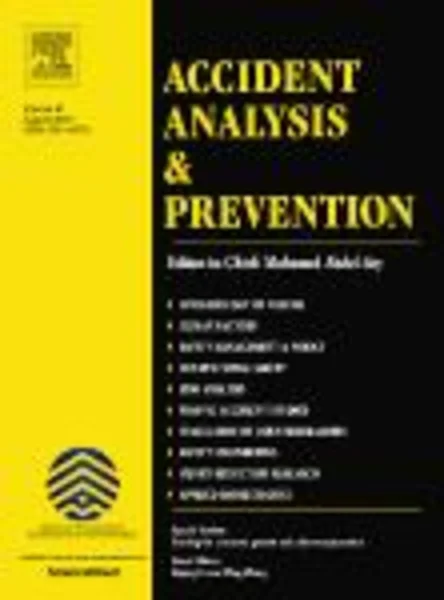-
age and years in practice as factors associated with needlestick and sharps injuries among health care workers in a portuguese hospital
جزئیات بیشتر مقاله- تاریخ ارائه: 1392/01/01
- تاریخ انتشار در تی پی بین: 1392/01/01
- تعداد بازدید: 945
- تعداد پرسش و پاسخ ها: 0
- شماره تماس دبیرخانه رویداد: -
health care workers are attributed to the group at highest risk of occupationally acquired bloodborne diseases as the result of contact with blood and body fluids. a cross sectional study was conducted between november 2009 and february 2010 in the north of portugal, to identify potential risk factors for needlestick and sharps injuries. a questionnaire was provided to 363 health care professionals. logistic regression was used to identify risk factors associated to needlestick and sharps injuries, calculating odds ratio (or) and their 95% confidence interval (ci). sixty-five percent of health care workers (64.5%, 234/363) reported needlestick and sharps injuries in the previous 5 years. of the injured workers, 74.8% were nurses. of the total injuries reported, the commonest were from syringe needle unit. the multivariate logistic regression model showed that the strongest risk factor was having more than 10 years or more of work in health services (or 3.37, 95% ci 1.82, 6.24). another significantly related factor was being over 39 years-old (or 1.94, 95% ci 1.03, 3.63). in portugal, there is a lack of epidemiological evidence related to needlestick and sharps injuries. considering that patients infected with hepatitis b and c virus are commonly encountered in the hospital environment and that the prevalence of hiv infection in portugal is one of the highest in europe, these results should be considered in the design of biosafety strategies at the hospital center.
مقالات جدیدترین رویدادها
-
استفاده از تحلیل اهمیت-عملکرد در ارائه الگوی مدیریت خلاقیت سازمانی و ارائه راهکار جهت بهبود
-
بررسی تاثیر ارزش وجوه نقد مازاد بر ساختار سرمایه شرکت های پذیرفته شده در بورس اوراق بهادار تهران
-
بررسی تأثیر سطح افشای ریسک بر قرارداد بدهی شرکت های پذیرفته شده در بورس اوراق بهادار تهران
-
بررسی تأثیر رتبه بندی اعتباری مبتنی بر مدل امتیاز بازار نوظهور بر نقد شوندگی سهام با تأکید بر خصوصی سازی شرکت ها
-
تأثیر آمیخته بازاریابی پوشاک ایرانی بر تصویر ذهنی مشتری پوشاک ایرانی (هاکوپیان)
-
شناخت مفهوم گردشگری الکترونیک و تفاوت شناخت حاصل از گردشگری واقعی و گردشگری مجازی
-
بررسی پارامترهای موثر در نفوذ کامل پرتابه در اهداف بتنی
-
نتایج کوتاه مدت جراحی آرتروسکوپی دررفتگی مکرر جلویی شانه
-
مقایسه روشهای تراکم ژیراتوری و مارشال جهت تهیه نمونه های آزمایشگاهی برای بررسی رفتار مکانیکی آسفالت به عنوان هسته آسفالتی
-
مدل سازی موتور استنتاج فازی ممدانی با استفاده از شبکه های پتری رنگی سلسه مراتبی
مقالات جدیدترین ژورنال ها
-
مدیریت و بررسی افسردگی دانش آموزان دختر مقطع متوسطه دوم در دروان کرونا در شهرستان دزفول
-
مدیریت و بررسی خرد سیاسی در اندیشه ی فردوسی در ادب ایران
-
واکاوی و مدیریت توصیفی قلمدان(جاکلیدی)ضریح در موزه آستان قدس رضوی
-
بررسی تاثیر خلاقیت، دانش و انگیزه کارکنان بر پیشنهادات نوآورانه کارکنان ( مورد مطالعه: هتل های 3 و 4 ستاره استان کرمان)
-
بررسی تاثیر کیفیت سیستم های اطلاعاتی بر تصمیم گیری موفق در شرکتهای تولیدی استان اصفهان (مورد مطالعه: مدیران شرکتهای تولیدی استان اصفهان)
-
بررسی تاثیر هوش تجاری بر رفتار مصرف کنندگان محصولات فرهنگی-رسانه ای
-
بررسی قابلیت استفاده از نسبت دوپونت به منظور پیش بینی سودآوری و ﺑﺎﺯﺩﻩ سهام (مطالعه موردی: صنعت دارویی بورس تهران)
-
بررسی روش های کنترل فرسایش بادی خاک و نقش آن در کاهش انتشار ریز گردها در مناطق خشک و نیمه خشک
-
تبیین طبایع چهارگانه در احادیث طبی اهل بیت (ع) و مقایسه ی آن با طب اخلاطی
-
experience of using magnesium sulfate infusion in the operating room to induce analgesia after laparoscopic cholecystectomy




سوال خود را در مورد این مقاله مطرح نمایید :